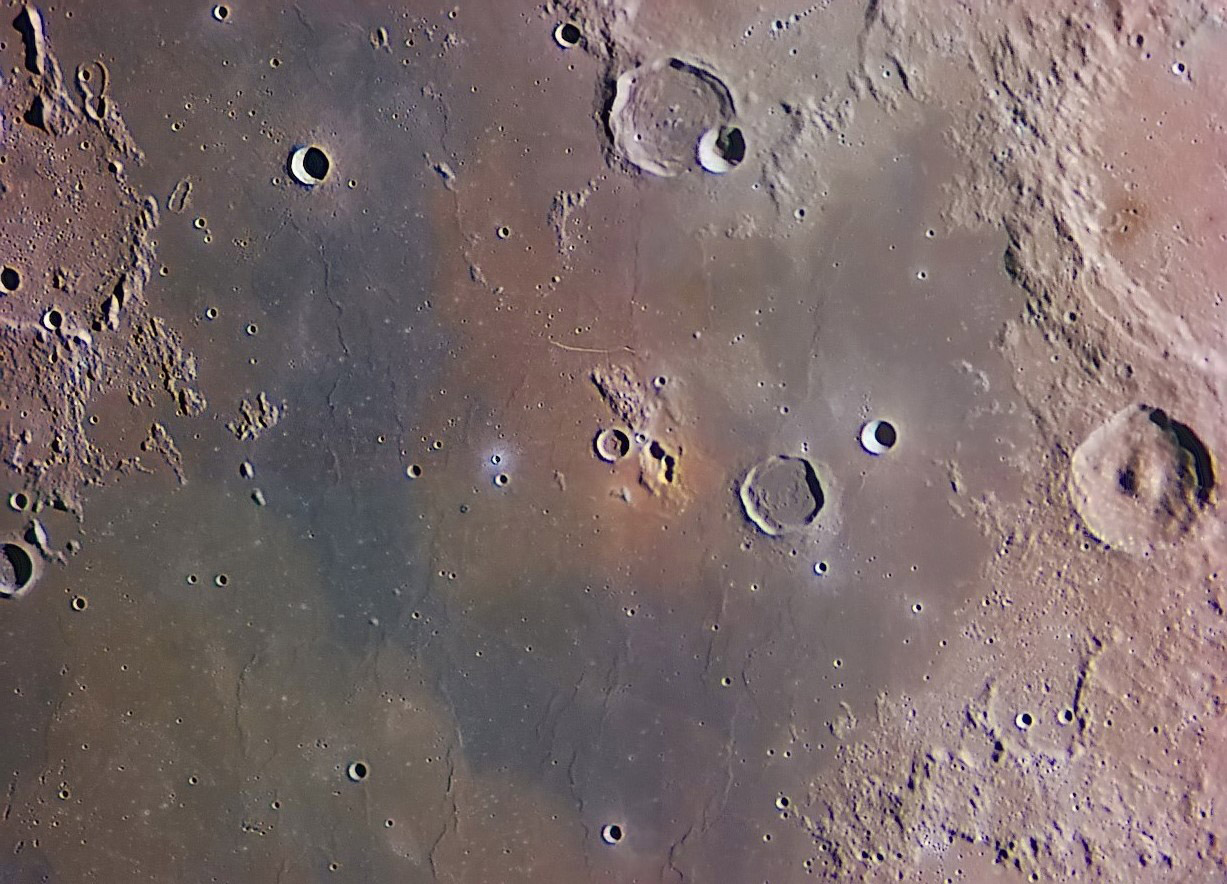Difference between revisions of "October 29, 2014"
| Line 6: | Line 6: | ||
<em>image by [mailto:beamtech@iprimus.com.au Stefan Buda], Australia</em><br /> | <em>image by [mailto:beamtech@iprimus.com.au Stefan Buda], Australia</em><br /> | ||
<br /> | <br /> | ||
| − | LPOD has featured a number of color saturated images that show subtle differences in hue, mostly between lavas of different compositions. As Stefan pointed out to me, most are synoptic views of low resolution. He has now provided a high resolution view of one of the most intriguing red spots that probably marks an explosive volcanic eruption site. The Lassell Massif appears as an intensely orange or yellow spot, with the most intense color concentrated in and around Lassell K, on the southern end of the massif. This volcanic spot has been known since the 1970s with the most recent [http://lpod. | + | LPOD has featured a number of color saturated images that show subtle differences in hue, mostly between lavas of different compositions. As Stefan pointed out to me, most are synoptic views of low resolution. He has now provided a high resolution view of one of the most intriguing red spots that probably marks an explosive volcanic eruption site. The Lassell Massif appears as an intensely orange or yellow spot, with the most intense color concentrated in and around Lassell K, on the southern end of the massif. This volcanic spot has been known since the 1970s with the most recent [http://www2.lpod.org/wiki/February_11,_2013 study] using LRO data in 2013. A prior LRO color [http://www2.lpod.org/wiki/October_16,_2011 mosaic] also showed this area as part of a regional view. And of course, LPOD has had earlier terrestrial [http://www2.lpod.org/wiki/January_31,_2010 views] as well. But Stefan's shows the most detail. I find the nearby lava flows are also quite interesting. A broad dark volcanic area extends from near the top left of the image to bottom right. This is darker than nearby lavas which are a light mustard hue. Without counting you can see that there are fewer small impact pits on the dark lava, indicating that it is younger than the surrounding flows. LRO altimetry data show that there is about a 400 m drop in elevation from the top/north to the bottom/south. Mare ridges on these younger lavas have the same orientation as ones in the older lavas, indicating that the stress field that causes low angle faulting had not changed. Stefan points out that a classic cinder cone-like [http://bit.ly/1tI6Dbj feature] is visible near Lassell J. LRO QuickMap measures give a basal diameter of 2.6 km and a height of 100 m for the cone, and show that it is embayed by surrounded by later lavas. Wouldn't it be lovely to have high-res color images like this for the entire Moon!<br /> |
<br /> | <br /> | ||
<em>[mailto:tychocrater@yahoo.com Chuck Wood]</em><br /> | <em>[mailto:tychocrater@yahoo.com Chuck Wood]</em><br /> | ||
| Line 14: | Line 14: | ||
<br /> | <br /> | ||
<strong>Related Links</strong><br /> | <strong>Related Links</strong><br /> | ||
| − | <em>[ | + | <em>[[21st Century Atlas of the Moon|21st Century Atlas]]</em> chart 16.<br /> |
<br /> | <br /> | ||
<p><b>Yesterday's LPOD:</b> [[October 28, 2014|Britannic Moon]] </p> | <p><b>Yesterday's LPOD:</b> [[October 28, 2014|Britannic Moon]] </p> | ||
Latest revision as of 08:36, 28 October 2018
Yellows - Bright and Pale

image by Stefan Buda, Australia
LPOD has featured a number of color saturated images that show subtle differences in hue, mostly between lavas of different compositions. As Stefan pointed out to me, most are synoptic views of low resolution. He has now provided a high resolution view of one of the most intriguing red spots that probably marks an explosive volcanic eruption site. The Lassell Massif appears as an intensely orange or yellow spot, with the most intense color concentrated in and around Lassell K, on the southern end of the massif. This volcanic spot has been known since the 1970s with the most recent study using LRO data in 2013. A prior LRO color mosaic also showed this area as part of a regional view. And of course, LPOD has had earlier terrestrial views as well. But Stefan's shows the most detail. I find the nearby lava flows are also quite interesting. A broad dark volcanic area extends from near the top left of the image to bottom right. This is darker than nearby lavas which are a light mustard hue. Without counting you can see that there are fewer small impact pits on the dark lava, indicating that it is younger than the surrounding flows. LRO altimetry data show that there is about a 400 m drop in elevation from the top/north to the bottom/south. Mare ridges on these younger lavas have the same orientation as ones in the older lavas, indicating that the stress field that causes low angle faulting had not changed. Stefan points out that a classic cinder cone-like feature is visible near Lassell J. LRO QuickMap measures give a basal diameter of 2.6 km and a height of 100 m for the cone, and show that it is embayed by surrounded by later lavas. Wouldn't it be lovely to have high-res color images like this for the entire Moon!
Chuck Wood
Technical Details
03 October 2014. 16" Dall-Kirkham, DMK21AU04 camera, Astrodon R filter. Four panel mosaic.
Related Links
21st Century Atlas chart 16.
Yesterday's LPOD: Britannic Moon
Tomorrow's LPOD: From the Earth to the Moon (and Back)
COMMENTS?
Register, Log in, and join in the comments.



